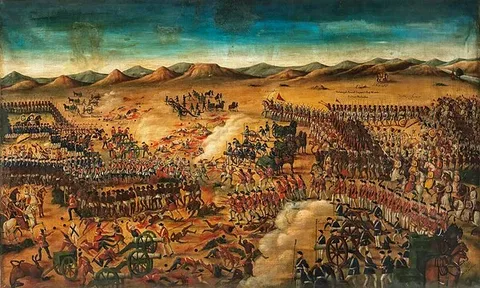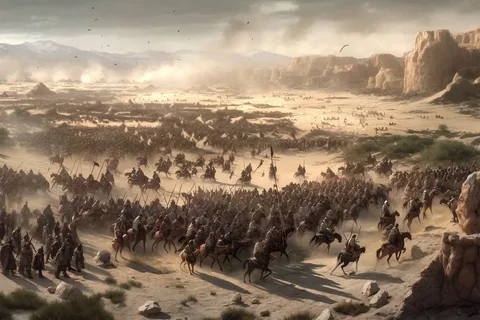The Battle of Umrat Al-Qadaa’ (7 Hijri) is an important event in early Islamic history that took place in the seventh year after the Hijra (Islamic migration), which corresponds to around 628 CE in the Gregorian calendar. This battle is associated with the aftermath of the Peace Treaty of Hudaybiyyah, which allowed the Muslims to perform an Umrah (minor pilgrimage) to Mecca after a period of state tension and conflict with the Quraysh tribe of Mecca.
Background and Context
After the Treaty of Hudaybiyyah was signed in the 6th year of Hijra, a truce was established between the Muslims of Medina and the Quraysh of Mecca. This treaty was crucial as it provided Muslims with peace and an opportunity to consolidate their strength and increase their political outreach. As part of the treaty terms, the Muslims were allowed to enter Mecca in the following year for three days to perform Umrah peacefully.
The Umrah that the Prophet Muhammad (PBUH) performed following this agreement is often referred to as “Umrat Al-Qadaa” because it was a makeup or compensatory Umrah that fulfilled the original intention that had been obstructed the previous year when the Muslims were prevented from entering Mecca. It was conducted in Dhu al-Qadah of the 7th Hijri year.
The Battle of Umrat Al-Qadaa’

While the Umrah itself was peaceful, the background military movements and minor conflicts around the time are linked to the campaign called the Battle of Umrat Al-Qadaa.
This campaign involved the Prophet Muhammad (PBUH) leading a contingent of roughly 2,000 Muslims towards Mecca following the treaty. The primary objective was to perform Umrah peacefully, but it was also a demonstration of Muslim strength and diplomatic success following years of hostilities.
During this time, some skirmishes and expeditions were conducted by the Muslims to protect their interests and respond to threats from hostile tribes plotting against Islam. For example, the Prophet sent groups including notable companions such as Bashir bin Sa’d and Akhram bin Abu Aujah on expeditions against tribes like Banu Murrah and Banu Sulaim, respectively. These tribes had posed threats by attempting to attack Muslim caravans or plotting with enemies against the Muslim community. These encounters involved fights where Muslims defended themselves effectively, although some Muslims were martyred in the clashes.
One report details an incident where the Muslims were ambushed, but a miraculous flood in a nearby valley prevented their pursuers from advancing, allowing the Muslims to escape with captured animals intact. These military responses were key to securing the safety and stability of the new Muslim state during the sensitive period after Hudaybiyyah.
Significance of the Event
Umrat Al-Qadaa’ marks a critical point because it symbolized the growing acceptance and legitimacy of Islam in the Arabian Peninsula. The peaceful entry into Mecca to perform Umrah showcased the rising influence of the Muslims and the Prophet’s diplomatic acumen.
The military expeditions linked to this period reflected the strategic approach of the Prophet in consolidating Muslim power through a blend of peaceful diplomacy and tactical defense. This campaign also demonstrated the resilience and readiness of the Muslim community to protect their faith and territory.
Read more: The battle of Bahran (3 Hijri)
FAQs
What was Umrat Al-Qadaa'?
Umrat Al-Qadaa' refers to the compensatory Umrah performed by Prophet Muhammad (PBUH) in the 7th year of Hijra after the Hudaybiyyah treaty allowed Muslims to enter Mecca peacefully for pilgrimage.
Why was the Battle of Umrat Al-Qadaa' fought?
The battle was more a series of defensive expeditions and minor skirmishes during the period of performing Umrah, aimed at protecting Muslims from hostile tribes and ensuring the security of Muslim caravans.
How many Muslims participated in Umrat Al-Qadaa'?
Historical reports indicate that about 2,000 Muslims accompanied the Prophet Muhammad (PBUH) during the Umrat Al-Qadaa' campaign.
What was the outcome of the Battle of Umrat Al-Qadaa'?
The Muslims successfully performed the Umrah, demonstrated their strength, and defended themselves against hostile tribes, solidifying their position in Arabia.
What is the importance of Umrat Al-Qadaa' in Islamic history?
It represents a turning point where Muslims gained peaceful access to Mecca for pilgrimage, showcasing the rise of Islam as a political and religious force, and laying groundwork for the eventual Conquest of Mecca.
Conclusion
The Battle of Umrat Al-Qadaa’ in 7 Hijri, though not a large-scale battle in traditional terms, was a significant military and political event highlighting the transition of Islam from a persecuted faith to a recognized power in the Arabian Peninsula. It combined the peaceful fulfillment of a religious duty—Umrah—with military expeditions that defended the nascent Muslim community against external threats.
This phase set the stage for subsequent major events including the Conquest of Mecca in the 8th Hijri year. The blend of diplomacy, strategic patience, and military readiness during Umrat Al-Qadaa’ illustrates the holistic leadership of the Prophet Muhammad (PBUH) and provides valuable insights into early Islamic history.

